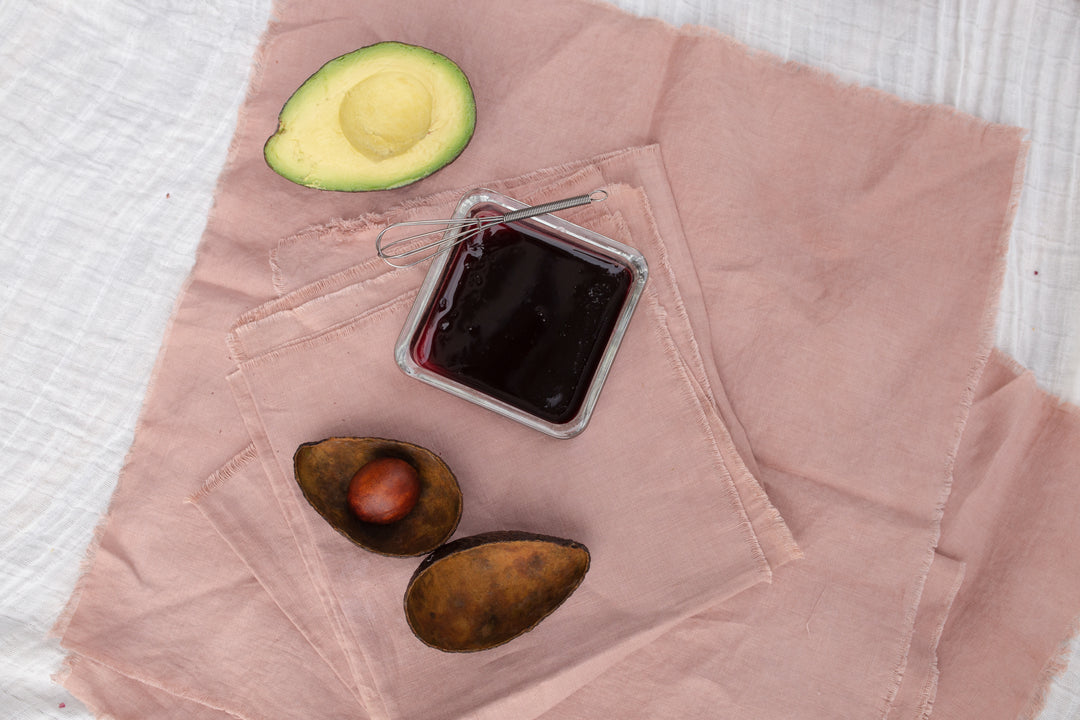Free Shipping in the US / 50% off all Clothing & Purses / No code needed, discount applied at checkout

Natural Dye DIY: Avocado
Posted on
by Carol Hargus (owner and dye artist)
You’d never know by looking at the fruit, but the pits and skins of Avocados produce lovely shades of pink when used to naturally dye! This is a beginner friendly, accessible and sustainable way to naturally dye fabric!
Whether you want to revive a garment that you love but feel is lacking a “soul”, or you want to start fresh with something new, avocados are a great way to explore natural dyeing at home.
This technique can be very rewarding, but it can also be frustrating if your garment doesn’t yield the results you are expecting– so make sure to keep an open mind.
SUPPLIES:
- Clean, blank fabric (natural fibers only) about 1/4lb in weight*
- Avocado pits/skins (about 12-14)
- Large stainless steel pot
- Clean bin or bucket for washing fabrics
- Water
- Non-iodized salt
- Tongs and spoon (stainless steel or wood)
- Colander
- Food thermometer
- Scrub Brush (for cleaning avocado pits/skins)
*If you don't have a scale a good reference for 1/4lb of fabric is about the weight of set of standard size pillowcases (2)
INSTRUCTIONS:
- Start by eating a lot of avocados. Instead of discarding the skins and pits, gently wash them clean of all fruit residue (a scrub brush works wonders) and let them air dry. Once dry, it is best to throw them in an airtight container in your freezer until you have collected a minimum of 12-14 pits and/or skins (choose either the pits or skins, don’t use both).
- Remove the pits/skins from the freezer and let them thaw naturally. In a non-reactive, stainless steel pot that is specifically dedicated to your dyeing experiments (ie: do not use this pot for cooking ever again), cover your avocado skins/pits with 2x as much water as plant matter. Next, add 1/4 cup of non-iodized salt, stir and bring the dye bath to a simmer, keeping the temperature between 140-160 degrees for about 45 minutes.
- While you are cooking your dye, pre-wash your textile in hot water, rinse and gently squeeze out the excess water. After your avocado has completed the dye extraction process in Step 2, you should have a lovely shade of dye bath ranging anywhere from a light amber color to a medium rosey shade.
- Immerse your wet textile in your dye pot and cook for 30-60 minutes, regulating the temperature between 140-160 degrees (it is vital that you stay within this degree range– if you cook above 160 degrees the color will brown). Diligently and gently stir the pot with a wooden spoon often. Strain out pits or skins using a colander.
- Turn off the heat and allow the textile to cool in your dye pot. Once it’s cooled, remove the fabric and gently squeeze out any excess liquids. Hang the fabric out of direct sunlight to allow it to air dry. After it’s dry, you’ll want to gently rinse the fabric by hand washing it in hot water with a few drops of PH neutral soap. Rinse it till the water runs clear. Repeat this gentle rinsing process and hang it again to air dry.
Voila! Enjoy your new creation and stay tuned for more plant magic journaling.
PLEASE NOTE:
- Color varies based on the season, region, soil conditions, etc. which the avocados were grown
- Some dyers may advise using Soy Milk as a “mordant” but I have found it to be unnecessary in my experiences and color studies using avocado.
- If you are trying to “cover up” a stain on a used piece of fabric this method is not going to work as the dye will avoid the area. A better method is a Bundle Dye/Eco Print method as this style is more likely to allow the stain to appear blended into the pattern. There is no guarantee in covering a stain with natural dye, especially if the stain is made from a chemical source. (try this tutorial for Eco Printing with Roses if you are trying to cover up a stain)
- Avocado is not considered to be a "Substantive" Dye meaning that it can fade over time. Keep fabrics out of direct sunlight to increase longevity of color.
Susan Clabby
March 30, 2021
You say “pits and/or skins (…don’t use both)”. Why?
Thanks
Leave a comment:
Quick links
Find Us / Reach Out
Austin, Texas USA
hello@wearesoulstudio.com
